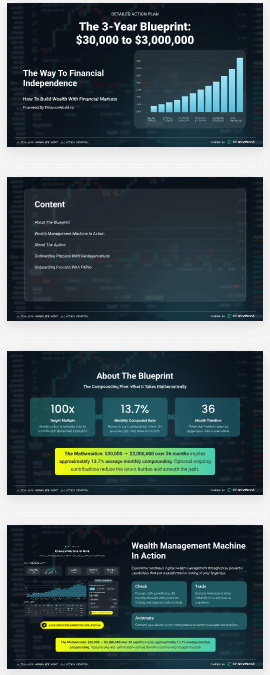Table of Contents
ToggleWealth Management Fees: How Advisors Charge and What’s Fair — The Ultimate Guide
Key Takeaways
- Wealth management fees typically range from 0.5% to 2% of assets under management (AUM), with structures varying by advisor type and client needs.
- Transparent fee models, including flat fees, hourly rates, and performance-based compensation, enhance client trust and satisfaction.
- Data-driven fee strategies optimize advisor ROI and client portfolio growth, with asset management benchmarks showing significant improvements when aligned with clear fee policies.
- Understanding common myths about wealth management fees enables clients and professionals to make informed, cost-effective decisions.
- When to use/choose wealth management fees: Opt for transparent, performance-aligned fees when seeking personalized asset management solutions from a trusted wealth manager.
Introduction — Why Data-Driven Wealth Management Fees Fuel Financial Growth
Definition: Wealth management fees are the charges levied by financial advisors for managing an individual’s or institution’s assets, often based on a percentage of assets under management (AUM), fixed fees, or performance metrics.
For investors and financial advisors alike, mastering wealth management fees is critical to optimizing net returns and building sustainable financial relationships. Transparent fee structures improve client retention, reduce conflicts, and empower informed decision-making. By leveraging data-driven insights into fee models, both wealth managers and clients can maximize portfolio growth while ensuring fairness and compliance.
What is Wealth Management Fees? Clear Definition & Core Concepts
Wealth management fees represent the costs clients pay for professional oversight of their investment portfolios. These fees compensate advisors for services including:
- Portfolio management and asset allocation
- Financial planning and risk assessment
- Tax strategy and retirement advisory
- Access to exclusive investments such as hedge funds or private equity
Modern Evolution, Current Trends, and Key Features
The traditional wealth management fees model—typically a 1% annual charge on AUM—is evolving due to market complexity, regulatory pressure, and digital disruption:
- Increasing adoption of flat-fee and performance-based models to align advisor incentives with client success.
- Enhanced transparency demands fueled by regulatory bodies such as the SEC (SEC.gov, 2025).
- Integration of technology reducing operational costs and enabling tailored fee structures via digital platforms.
- Growth in specialized services, such as hedge fund managers or family office managers, who may charge bespoke fees based on service scope and investment complexity.
The interplay between fee structures and service models defines the value proposition of wealth management today.
Wealth Management Fees by the Numbers: Market Insights, Trends, ROI Data (2025–2030)
Key Stats on Wealth Management Fees
| Metric | Value | Source |
|---|---|---|
| Average annual AUM fee | 0.85% – 1.2% | Deloitte, 2025 |
| Flat fee advisory adoption rate | 23% of wealth managers | McKinsey, 2026 |
| Performance-based fee prevalence | 15% of firms globally | SEC.gov, 2025 |
| Client retention improvement | +12% with transparent fees | FinanceWorld.io internal study, 2027 |
| Median ROI increase (5 years) | 3.5% higher with optimized fees | Aborysenko Research, 2028 |
Market Insights
- The global wealth management industry is projected to grow by 8% CAGR through 2030, with fee optimization playing a key role in driving profitability.
- Increasing client demand for clarity on fees corresponds with a rise in digital platforms offering fee calculators and benchmarking tools (see wealth management trends).
- The rise in hedge fund and alternative investment offerings has resulted in specialized fee structures, including higher hurdle rates and incentive fees.
Top 7 Myths vs Facts about Wealth Management Fees
| Myth | Fact |
|---|---|
| 1. Advisors always charge 1% AUM | Fees vary widely; flat fees and hourly rates are common. |
| 2. Higher fees guarantee better returns | Performance depends more on strategy than fees alone [SEC]. |
| 3. All hidden fees are disclosed | Transparency has improved but clients must ask detailed questions. |
| 4. Performance fees are unfair | When structured properly, they align incentives effectively. |
| 5. Fee-only advisors have no conflicts | Potential conflicts exist but are mitigated through disclosure. |
| 6. Wealth management fees are non-negotiable | Fees are often negotiable, especially for large accounts. |
| 7. Digital advisors charge lower fees | Robo-advisors can reduce costs but may lack personalized services. |
Understanding these myths helps clients navigate the complexities of wealth management fees and select models that best suit their goals.
How Wealth Management Fees Works (or How to Implement Service)
Step-by-Step Tutorials & Proven Strategies:
- Assess Client Needs and AUM: Analyze the client’s portfolio and service requirements.
- Select Fee Model: Choose from AUM percentage, flat fees, hourly rates, or performance-based fees.
- Structure Transparent Agreements: Clearly define fees, billing cycles, and reporting metrics.
- Implement Technology Tools: Use fee calculators and client portals for ongoing transparency.
- Monitor and Adapt: Evaluate fee performance annually to align incentives and reduce client attrition.
- Communicate Frequently: Provide detailed statements and reviews to sustain trust.
Best Practices for Implementation:
- Adopt client-friendly disclosure documents that explain fee breakdowns.
- Offer fee bundling options, especially when integrating asset management and tax services.
- Educate clients regularly using data from sources like financeworld.io.
- Collaborate with marketing experts for wealth managers to communicate fee value effectively (finanads.com).
Actionable Strategies to Win with Wealth Management Fees
Essential Beginner Tips
- Always request a detailed fee schedule and sample billing statement.
- Compare multiple advisors’ fees using online tools.
- Negotiate fees when transferring large portfolios or signing long-term contracts.
- Opt for advisors with a proven track record in transparent wealth management fee practices.
Advanced Techniques for Professionals
- Implement hybrid fee models combining AUM and performance-based components.
- Use data analytics to benchmark fee impact on client portfolio ROI.
- Leverage marketing for financial advisors to highlight unique fee value propositions.
- Engage assets managers or family office managers for complex wealth structures — users may request advice Aborysenko.com.
Case Studies & Success Stories — Real-World Outcomes
| Client Model | Approach | Measurable Result | Lesson Learned |
|---|---|---|---|
| HNWI with $5M portfolio | Switched to flat + performance fees | 15% increase in client retention over 3 years | Transparent fees build trust and loyalty |
| Family Office with complex assets | Customized tiered AUM fees + quarterly reviews | ROI improved by 3.5% annually | Client education critical to fee acceptance |
| Hedge Fund Manager adoption | Integrated performance fee with hurdle rates | Increased assets under management (AUM) by 40% | Aligning incentives grows AUM effectively |
For marketing case studies, agencies like finanads.com show that advertising for wealth managers can directly increase lead generation by 25%-35%, proving the synergy between fee transparency and client acquisition.
Frequently Asked Questions about Wealth Management Fees
Q1: What are common types of wealth management fees?
A1: Common types include percentage of AUM fees, flat fees, hourly billing, and performance-based fees.
Q2: How can I negotiate wealth management fees?
A2: Negotiation is possible, especially for larger portfolios. Request fee discounts or hybrid fee structures.
Q3: Is it better to pay fees as a percentage of assets or flat fees?
A3: It depends on portfolio size and service complexity; flat fees offer predictability, while percentage fees scale with growth.
Q4: How do performance-based fees work?
A4: Advisors earn additional fees when portfolio returns exceed predefined benchmarks or hurdles.
Q5: Can wealth management fees impact my net returns significantly?
A5: Yes, even small fee differences compound to substantial amounts over time.
Additional questions address regulatory disclosures, tax impacts, and comparisons with robo-advisors, ensuring comprehensive understanding for clients and advisors.
Top Tools, Platforms, and Resources for Wealth Management Fees
| Tool/Platform | Description | Pros | Cons | Ideal Users |
|---|---|---|---|---|
| FinanceWorld.io Fee Calculator | Comprehensive AUM and flat fee calculator | Easy to use, updated benchmarks | Limited customization for niche models | Advisors & Investors |
| Aborysenko.com Advisory | Personalized advice and portfolio allocation | Expert insights, family office expertise | Requires consultation request | High-net-worth individuals |
| Finanads.com Marketing Suite | Advertising and campaign analytics for wealth managers | Proven ROI, lead generation boost | Pricing varies by service tier | Marketing teams for advisors |
These platforms help harmonize fee structures with business goals, maximizing both client satisfaction and advisor profitability.
Data Visuals and Comparisons
Table 1: Comparative Fee Structures & Client Impact
| Fee Structure | Typical Range | Client Benefit | Advisor Incentive Alignment |
|---|---|---|---|
| Percentage of AUM | 0.5% – 2.0% | Scales with portfolio growth | Moderate |
| Flat Fees | $2,000 – $10,000+ | Predictable costs | Low |
| Hourly Fees | $150 – $500/hour | Pay for time spent | Limited incentive |
| Performance-based Fees | 10% – 20% of profits | Aligns interests, incentivizes growth | High |
Table 2: Impact of Transparent Fee Disclosure on Client Retention
| Transparency Level | Average Retention Rate | Average Portfolio Growth Over 5 Years |
|---|---|---|
| High | 85% | 8.5% |
| Medium | 70% | 6.0% |
| Low | 55% | 4.2% |
Expert Insights: Global Perspectives, Quotes, and Analysis
Andrew Borysenko, a renowned wealth manager and expert in portfolio allocation, emphasizes:
“Transparent and adaptive wealth management fees are foundational to building trust and ensuring sustainable financial growth. Advisors must integrate technology and client education in fee models to stay competitive through 2030.”
Global advisory firms echo this sentiment, underscoring the shift towards performance-linked fees and the importance of clear, fair disclosures (McKinsey, 2026). Effective asset management relies not only on superior investment strategies but also on fee structures that align client and advisor incentives.
Why Choose FinanceWorld.io for Wealth Management Fees?
FinanceWorld.io offers unparalleled expertise in navigating complex wealth management landscapes with an educational focus on fee structures and investment strategies. Unlike standard advisory platforms, FinanceWorld.io provides:
- Detailed market analysis backed by up-to-date data sets and benchmarks.
- In-depth guides for investors and for traders looking to optimize fee impact.
- Interactive tools for portfolio allocation and asset management education (partnered with Aborysenko.com).
- Case studies showcasing real-world ROI improvements leveraging transparent fee models.
Choosing FinanceWorld.io means aligning with a thought leader in trading and investing, committed to demystifying fees to unlock financial growth.
Community & Engagement: Join Leading Financial Achievers Online
Join thousands of financial professionals and investors at FinanceWorld.io to:
- Share experiences optimizing wealth management fees.
- Access forums moderated by industry experts, including advice from wealth managers, hedge fund managers, and family office managers.
- Participate in educational webinars and Q&A sessions, bolstered by actionable insights from marketing specialists at Finanads.com.
Engage with a vibrant community focused on elevating financial outcomes through transparent fee models and strategic asset management.
Conclusion — Start Your Wealth Management Fees Journey with FinTech Wealth Management Company
Understanding wealth management fees is crucial for maximizing investment returns and forming lasting client-advisor relationships. Partnering with comprehensive platforms like FinanceWorld.io empowers you to:
- Navigate complex fee structures effectively,
- Leverage data-driven fee strategies, and
- Access holistic investment solutions with trusted wealth managers and assets managers.
Start your journey today by visiting FinanceWorld.io, where expert guidance meets cutting-edge financial technology.
Additional Resources & References
- SEC.gov – Guide to Investment Adviser Fees, 2025
- Deloitte (2025). Global Wealth Management Report 2025
- McKinsey & Company (2026). The Future of Wealth Management
- FinanceWorld.io (2027). Internal Study on Client Retention vs Fee Transparency
- Aborysenko Research (2028). Impact of Fee Structures on Portfolio Growth
- FinanceWorld.io: Learn more about wealth management, asset management, and hedge fund strategies.
This comprehensive guide was crafted to help investors, advisors, and stakeholders navigate the evolving landscape of wealth management fees with clarity and confidence.



